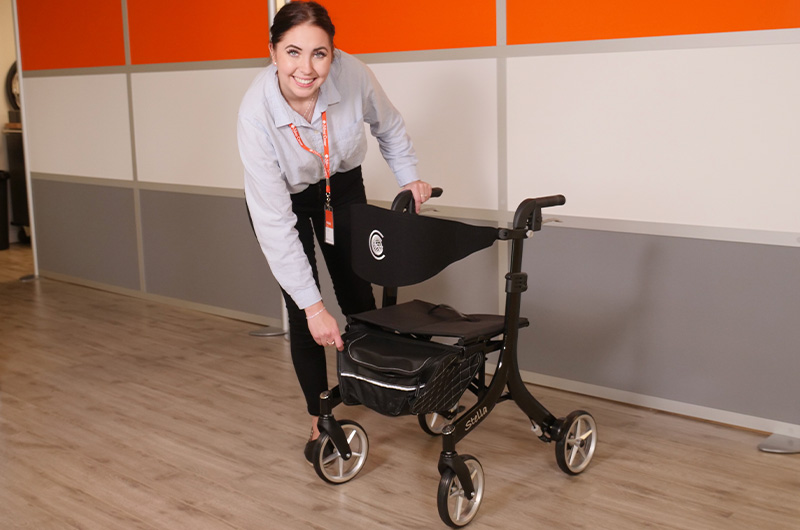All About Walkers and Rollators
What is the difference between a rollator and a walker?
Walkers and rollators are mobility aids designed for people who are are unstable to walk, have difficulty walking more than a few steps, or are recovering from surgery and need additional support and stability while walking. Rollators include wheels on all legs (three or four, depending on the model), whereas walkers come without wheels or with wheels on the front two legs. A standard walker without wheels offers the most support but requires you to lift it with every step you take. Rollators offer support without slowing down your walking pace.
Walkers are designed for short-term use at home or for short distances. They can offer some support after surgery and are inexpensive.
Rollators are better suited for long-term use than walkers and are more popular than walkers. The wheels are typically larger than a standard two-wheel walker, they are more convenient to use outdoors and over rough or uneven terrain. Rollators usually incorporate a seat making them handy for the user to rest at any time.
What are walkers?
Walkers are frames made from lightweight metal such as aluminum. Walkers are adjustable to accommodate the height of the user. Many are foldable for easy storage.
Standard walkers without wheels are the most basic type of walker available. The user needs to pick up the walker to move. They are best used to travel short distances or if stability is the main concern. People with a tendency to fall forward will find this type of walker most useful. Most standard walkers are foldable for easy storage or to stow in a car for travel purposes.
Two-wheel walkers have casters on the front two legs and rubber tips on the rear legs. The user can put his/her weight on the walker while moving and the rubber tip legs prevent the walker from rolling.
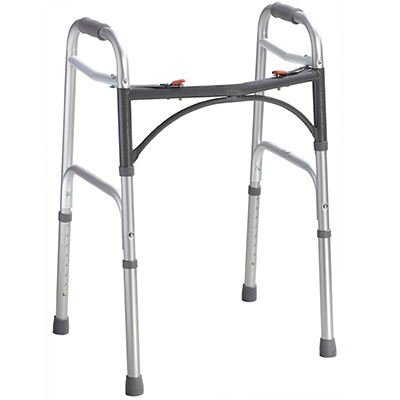
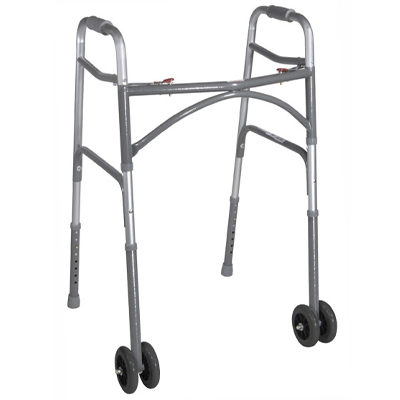
What are rollators?
Rollators are frames that come with hand-operated brakes that can be engaged by the user. The front wheel(s) swivel, making it easier to turn. The wheels are typically larger than a standard two-wheel walker, so it is more convenient to use outdoors and over rough or uneven terrain.
Rollators can be three-wheel, four-wheel, or heavy-duty. Three-wheel rollators have one swivelling wheel in the front and two wheels in the back. They are easy to maneuver and can make tight turns, making them preferred for indoor use. They also tend to be lighter and more portable than four-wheel rollators. However, they do not have a seat and do not provide as much stability and support as four-wheel rollators. They often come with a basket, pouch, or both for storage.
Four-wheel rollators have two swivelling wheels in the front and two wheels in the back. Most come with a seat that may be padded, are bands or hard plastic so the user can rest. They provide more support and stability than three-wheel rollators. A storage basket or tote bag is normally located under the seat.
Heavy-duty rollators, also known as bariatric rollators, have a higher weight capacity than standard rollators. Standard rollator seats are about 15″ wide while heavy-duty rollator seats are wider, usually about 19″ wide. The weight capacity for most heavy-duty rollators is between 400 lb and 500 lb. These four-wheel rollators usually feature reinforced steel frames and wider seats. The wheels are usually larger and wider than standard rollators so the rollator is well supported and does not sink if the ground is soft.
What does type 1, 2, and 3 mean?
Walkers and rollators are classified as type 1, 2, and 3. All walkers are type 1, whether they have wheels or not. These are best for short-term use. Type 2 rollators come with smaller 4- to 6-inch wheels. Type 2 rollators are designed for use indoors and in environments with level ground such as a retirement home garden, short neighbourhood walks, and so on. Type 3 rollators come with larger, 8-inch wheels. Type 3 rollators offer further mobility, come with a seat, and bigger wheels.
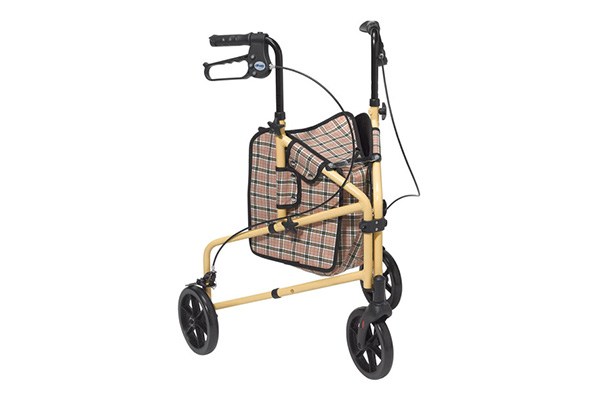
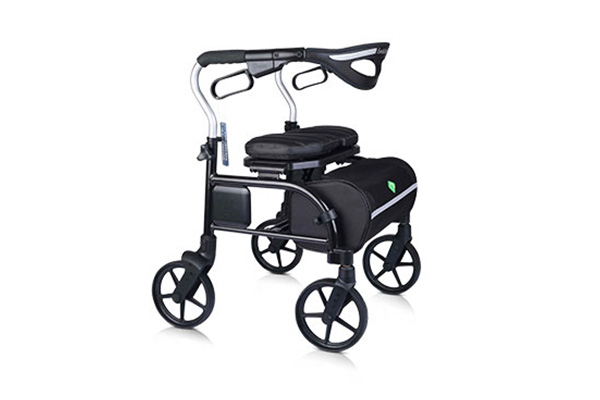
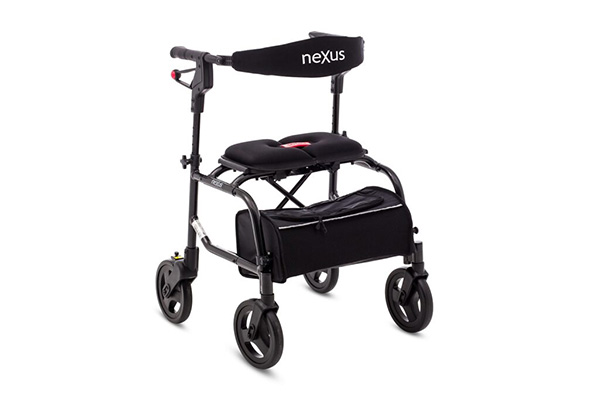
What are the features of walkers and rollators?
Frames
Most walker frames are made from 1″ aluminum tubing and are lightweight. The height of the walker can usually be adjusted by 5-10″ depending on the model. Rollators can also be made from lightweight frames that are usually aluminum. Steel frames are stronger and recommended for users over 250 lb.
Hand Grips
Hand grips are located on either side of the walker or rollator. They are generally made from plastic, foam or other soft materials like gel. If the manufacturer’s supplied grip isn’t comfortable, it can be replaced with one that is. If the user has hands with a tendency to sweat, a soft or foam grip might work better. Larger grips are suited for people with arthritis or with other grasping issues.
Wheels
The wheels or “casters” on a two-wheel walker are normally 3–5″ and do not swivel. Rollators with larger wheels are easier to push. Larger wheels (8” or more) also make it easier to go over rough or uneven terrain, making them better for outdoor use. Small, solid wheels are recommended for indoor use since they maneuver around tight spaces better.
Baskets
Walkers do not typically come with a basket, but some manufacturers make an optional attachment. Bags are alternatively available for storage. Most rollators come with baskets or pouches to carry personal items or groceries.
Brakes
Walkers do not come with brakes.
There are several different types of brake systems for rollators, including push-down and cable loop. The cable loop brake system is the most common. It works much like brakes on a bike. The brakes are engaged by squeezing the handles and levers simultaneously with both hands. Every rollator with a seat should have brakes that lock. The brakes should lock so the rollator doesn’t roll away when the user is sitting on the seat. You should fully engage the brakes before you sit down on the rollator and only disengage the brake when you are standing and ready to walk.
Push-down brakes require the user to provide downward pressure on the spring-loaded frame to stop rolling. The brakes are easy to engage, since all the user has to do is simply lean on the rollator. The brakes are released when the pressure is lifted. They may not be suited for petite users who don’t weigh enough to engage the brakes or heavier users who unintentionally engage the brakes.
If you live in a hilly area, you may want a rollator with slow-down brakes. These allow you to set the tension for the brakes when you are going downhill so the rollator does not roll away from you.
Optional attachments
Most manufacturers offer optional attachments such as bags, trays, cup holders, etc. These are convenient and can enhance your walking experience. If you have a folding walker, be sure that the attachment will not get in the way of the folding mechanism. This can cause the walker to fold while you are using it. Attachments supplied by the manufacturer for specific models are normally built with the folding mechanism in mind.
Some rollator users may prefer a tote bag over a basket for storage purposes. When folding the rollator, the basket needs to be removed but the tote bag can remain attached.
How do I use a walker or rollator?
To use a standard walker, step between the handles and hold on to the grips. Next, lift the walker and place it in front of you, placing your weight on the walker. Now, you can take a step using the walker for support. You may find that the lift and step motion interrupts your natural gait.
To use a two-wheel walker or rollator, situate yourself between the handles. Hold on to the grips and push the walker forward. Using the walking for support and balance, take a step inside the walker with one foot and then the other. There is no lift and step motion, so you maintain a more natural gait.
